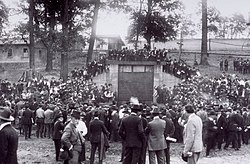Bruceton is an unincorporated suburb of Pittsburgh within Allegheny County, Pennsylvania, United States.[1] It is part of the Greater Pittsburgh metropolitan region. Its western half is part of South Park Township and its eastern half is part of Jefferson Hills.
Bruceton, Pennsylvania | |
|---|---|
 Dedication of the Experimental Mine, 1910 | |
 | |
| Coordinates: 40°18′17″N 79°58′53″W / 40.30472°N 79.98139°W | |
| Country | United States |
| State | Pennsylvania |
| County | Allegheny |
| Borough/Township | Jefferson Hills, South Park |
| Elevation | 961 ft (293 m) |
| Time zone | UTC-5 (EST) |
| • Summer (DST) | UTC-4 (EDT) |
Bruceton is the home of the Experimental Mine of the U.S. Bureau of Mines, which originally opened in 1910.[2][3] It is also the home of the Pittsburgh Safety and Health Technology Center. The Pittsburgh and West Virginia Railway connected to the B&O Railroad in Bruceton. It is 185 miles (or 298 km) northwest of Washington D.C.[citation needed]
History
editIn the early 1940s, the town hosted almost 100 scientists to help develop the Manhattan Project as a laboratory of the National Defense Research Committee including a month-long visit by Linus Pauling.[4][5][6]
See also
editReferences
edit- ^ "Bruceton, Pennsylvania". Geographic Names Information System. United States Geological Survey, United States Department of the Interior.
- ^ "About NETL". Archived from the original on December 20, 2008. Retrieved November 15, 2008.
- ^ Clements, M.E. (1927). "Uncle Sam's Toy Coal Mine". Popular Science (July): 36. Archived from the original on June 4, 2011. Retrieved March 7, 2010.
- ^ "The Scientific War Work of Linus C. Pauling - Special Collections & Archives Research Center - Oregon State University".
- ^ Lillian Hoddeson; Paul W. Henriksen; Roger A. Meade; Catherine L. Westfall (February 12, 2004). Critical Assembly: A Technical History of Los Alamos During the Oppenheimer Years, 1943-1945. Cambridge University Press. pp. 166–. ISBN 978-0-521-54117-6.
- ^ Peter Galison; Bruce William Hevly (1992). Big Science: The Growth of Large-scale Research. Stanford University Press. pp. 270–. ISBN 978-0-8047-1879-0.